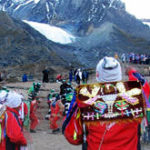With 3,000 festivals a year, Peru is a country that knows how to celebrate. Everything from religious rituals, vigorous dance-offs, flamboyant beauty pageants, and streets packed with local cuisine to taste and craftsmanship to gander at its close to impossible to end a trip to Peru without partaking in at least on festival and falling in love with the vibrantly colorful peruvian spirit. Below are just a couple highlighted festivals that take place in the months of September to December to add some traditional flare to your Peru travels.
September – International Spring Festival
This festival, during the final week of September, is vibrantly celebrated all over Peru, but the town of Trujillo has taken it to the next level of splendor. The entire city is blanketed with celebratory decorations and parades of floats and school children dance through the streets. The main event is the couples, with bright handkerchiefs waving through the air to keep the beat , dancing the traditional marinera nortena. Each region adds its own spice to the step to compete during this week long festival. And of course, there is an elaborately adorned King and Queen of Spring that parades through the streets accompanied by drumming bands whom have traveled from all over to take part in this lively festival.

October – The Lord of Miracles
October 18-28 Lima packs out with purple, tunic adorning pilgrims singing hymns and shouting prayers to celebrate the Lord of Miracles, making this the largest procession in South America. The tradition dates back to the Angola slaves of the colonial period who painted an image of a black African Christ on the side of a plantation building that proved resilient despite several attempts to erase it and even the 1746 earthquake which leveled the surrounding buildings. The still existing painting, weighing two tons, is paraded through the streets on the backs of believers during the 24 hour procession. Along with being quite a powerful sight of faithful religious devotion, the streets are also lined with traditional food vendors for those with a faithful devotion to their stomachs. The Turron de Dona Pepa, an anis cookie bar with candied syrup and a confetti of colorful sprinkles on top, is a classic satisfier for the hungry patrons. A gory, yet culturally interesting attraction for tourists is a commemorative bullfight in the centuries old Plaza de Acho to honor the Lord of Miracles.

November – The Emergence of Manco Capac and Mama Ocllo
In November the cities of Palpa(Nov 1-7), Puno (Nov 2-8), Moquegua (Nov 20-26), Pasco (Nov 21-30), and Tumbes (Nov 22-26) celebrate a “tourist week” where all the traditions of Peru are gathered for the enjoyment of the tourists. Local foods to try, traditional dances to watch, and handmade crafts to buy make this a convenient cultural experience. For a more local driven festival visit Puno on November 5th for the Emergence of Manco Capac and Mama Ocllo. Legend has it that these two mythical beings arose from the waters of Lake Titicaca and founded the Inca Empire. Over 200 local artists conspire together to reproduce the mythical couples resurrection from the lake out of reeds. Quite a unique cultural spectacle and a must see if you are on a Peru tour in the area.
December – Banana and Scissor Dance Festival
Banana is one of the largest fruit crops produced in the northern town of San Martin and a huge source of income for the community, so rightfully they have a week long celebration to hono this prosperous crop. On December 1-6 the streets fill with all sorts of banana based food products as well as cultural activities to participate in. You will be amazed at what all you can make with a banana.

The Scissor Dance Festival (December 22-26 in Peruvian highlands region of Huancavelica) is immensely popular amongst the peruvian locals as well as awe struck tourists. The dance consists of two or more individuals with scissors in hand cutting the air to the beat of the violin and harp orchestras while bounding around with gymnastic-like maneuvers. The dance-off is judged based on physical difficulty, magical skill, and amount of blood drawn. They make running with scissors an intricate acrobatic spectacle rather than the a simple childhood rule to be broken.
Photo credits: Flickr Miguel Vera, chosicarelax & destacadosdelano.




